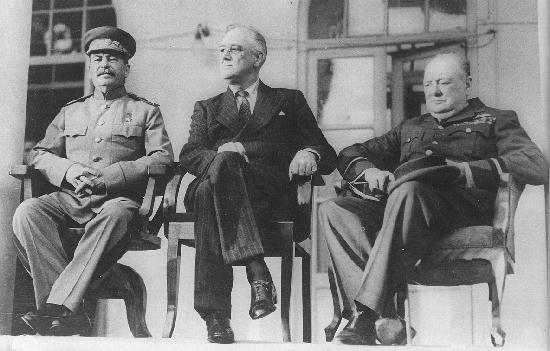
During World War II, tensions rose between the United States and the Soviet Union because of their different economic systems and the fact that before the war, the USSR had allied with Hitler. At a 1945 conference between the victorious nations in Potsdam, Germany, the Soviet Union wanted to take reparations from Germany to pay for heavy wartime losses. President Truman disagreed with this, claiming that it would lead to a situation similar to that of World War I in which Germany was punished heavily (money and rights were taken away after WWI). In addition to this, the Soviet Union was angry with the United States for keeping the production of the atomic bomb a secret.
After debating, the Powers decided that they would only take reparations from their own occupied zones. Also, because of the the Soviet Union's heavy losses, it felt entitled to making a buffer zone out of Eastern Europe to prevent another attack from the West. President Truman also disagreed with this, as he wanted to spread Capitalism and Democracy to Eastern Europe. In spite of Truman, Stalin established Communist governments in Albania, Bulgaria, Czechoslovakia, Hungary, Romania, and Poland. These countries became known as "satellite states" because though they were not officially part of Russia, Russia had complete control over them. Stalin even went so far as to say that Communism and Capitalism were incompatible and as a result, a war would break out between the United States and the Soviet Union.
In February 1946, George F. Kennan, an American diplomat in Moscow proposed a policy of containment, which meant limiting the expansion of Communist rule in other countries. This became a major facet of President Trumans's foreign policy. Truman then established the Truman Doctrine ("it must be the policy of the United States to support free peoples who are resisting attempted subjugation by armed minorities or by outside pressures"). An example of the Truman Doctrine in action: between 1947 and 1950, the United States Congress sent $400 million to Turkey and Greece, which stifled the Soviet Union's efforts to take control of the two small countries.

 Shortly after WWII finished, America, Great Britain, and France had control over the western half of Berlin, while the Soviets had control over the eastern half of Berlin. During this time, relations between the Soviet Union and the United States were already plummeting. As a result, in an attempt to take West Berlin for Russia, Stalin closed all highways leading into Berlin. In that part of Berlin, the citizens were in peril due to lack of food and resources. The United States and Great Britain responded to this action by creating the Berlin Airlift, which was when the two countries flew supplies and food into Berlin. After almost a year of this, the Soviet Union decided it would not prevail and thus lifted the blockade.
Shortly after WWII finished, America, Great Britain, and France had control over the western half of Berlin, while the Soviets had control over the eastern half of Berlin. During this time, relations between the Soviet Union and the United States were already plummeting. As a result, in an attempt to take West Berlin for Russia, Stalin closed all highways leading into Berlin. In that part of Berlin, the citizens were in peril due to lack of food and resources. The United States and Great Britain responded to this action by creating the Berlin Airlift, which was when the two countries flew supplies and food into Berlin. After almost a year of this, the Soviet Union decided it would not prevail and thus lifted the blockade.- Tiffany and Paul
One of the better written blogs I've seen. Strong details and the pictures were really nice. Very thorough blog.
ReplyDeleteVery long, yet interesting summary. Good job!
ReplyDeleteNice job because it is interesting and important to know how the cold war actually began. Maybe next time make the pictures a little smaller.
ReplyDeleteVery detailed, and the images went well with the text. Excellent job.
ReplyDeleteThe berlin airlift picture really brought the article to life. It is so cool seeing the Western success with Stalin's blockade. I agree with your title that the cold war was not very cold, although we never did have a battle directly.
ReplyDeleteDescriptive and information packed post, good job.
ReplyDeletereally great article, lots of information and the pictures add to all your thorough descriptions. Great job!
ReplyDeleteThe pictures were great. Also, it was well written with lots of factual details.
ReplyDeleteI like the pictures, especially the first one. The post is interesting and clear.
ReplyDelete